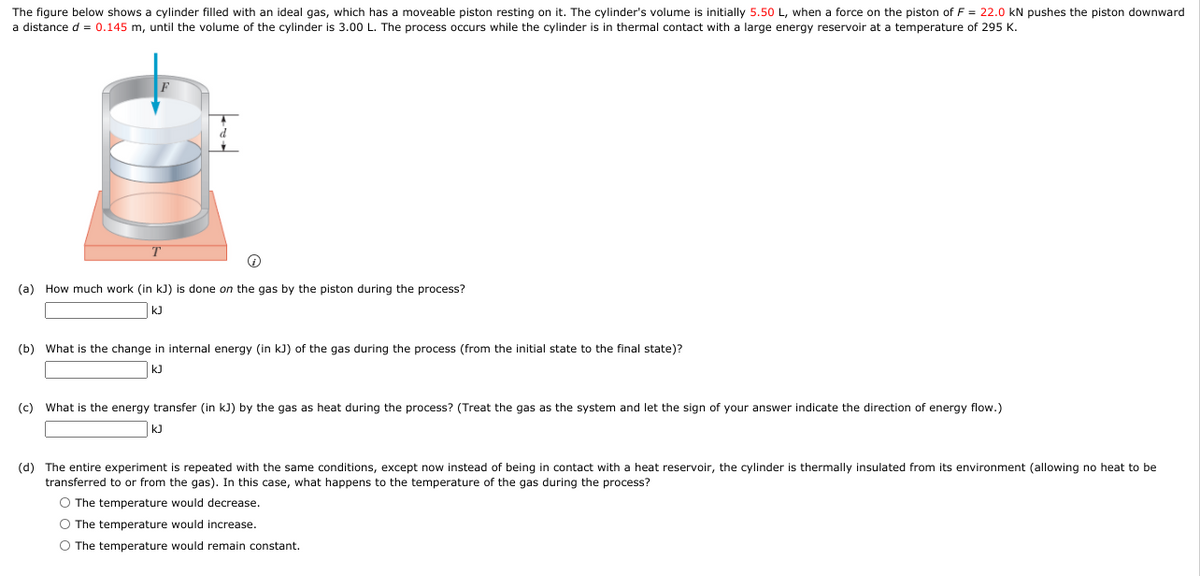The figure below shows a cylinder filled with an ideal gas, which has a moveable piston resting on it. The cylinder's volume is initially 5.50 L, when a force on the piston of F = 22.0 kN pushes the piston downward a distance d = 0.145 m, until the volume of the cylinder is 3.00 L. The process occurs while the cylinder is in thermal contact with a large energy reservoir at a temperature of 295 K. (a) How much work (in kJ) is done on the gas by the piston during the process? kJ (b) What is the change in internal energy (in kJ) of the gas during the process (from the initial state to the final state)? kJ (c) What is the energy transfer (in kJ) by the gas as heat during the process? (Treat the gas as the system and let the sign of your answer indicate the direction of energy flow.) kJ (d) The entire experiment is repeated with the same conditions, except now instead of being in contact with a heat reservoir, the cylinder is thermally insulated from its environment (allowing no heat to be transferred to or from the gas). In this case, what happens to the temperature of the gas during the process? O The temperature would decrease. O The temperature would increase. O The temperature would remain constant.
The figure below shows a cylinder filled with an ideal gas, which has a moveable piston resting on it. The cylinder's volume is initially 5.50 L, when a force on the piston of F = 22.0 kN pushes the piston downward a distance d = 0.145 m, until the volume of the cylinder is 3.00 L. The process occurs while the cylinder is in thermal contact with a large energy reservoir at a temperature of 295 K. (a) How much work (in kJ) is done on the gas by the piston during the process? kJ (b) What is the change in internal energy (in kJ) of the gas during the process (from the initial state to the final state)? kJ (c) What is the energy transfer (in kJ) by the gas as heat during the process? (Treat the gas as the system and let the sign of your answer indicate the direction of energy flow.) kJ (d) The entire experiment is repeated with the same conditions, except now instead of being in contact with a heat reservoir, the cylinder is thermally insulated from its environment (allowing no heat to be transferred to or from the gas). In this case, what happens to the temperature of the gas during the process? O The temperature would decrease. O The temperature would increase. O The temperature would remain constant.
Physics for Scientists and Engineers: Foundations and Connections
1st Edition
ISBN:9781133939146
Author:Katz, Debora M.
Publisher:Katz, Debora M.
Chapter21: Heat And The First Law Of Thermodynamics
Section: Chapter Questions
Problem 76PQ
Related questions
Question

Transcribed Image Text:The figure below shows a cylinder filled with an ideal gas, which has a moveable piston resting on it. The cylinder's volume is initially 5.50 L, when a force on the piston of F = 22.0 kN pushes the piston downward
a distance d = 0.145 m, until the volume of the cylinder is 3.00 L. The process occurs while the cylinder is in thermal contact with a large energy reservoir at a temperature of 295 K.
d
(a) How much work (in kJ) is done on the gas by the piston during the process?
kJ
(b) What is the change in internal energy (in kJ) of the gas during the process (from the initial state to the final state)?
kJ
(c) What is the energy transfer (in kJ) by the gas as heat during the process? (Treat the gas as the system and let the sign of your answer indicate the direction of energy flow.)
kJ
(d) The entire experiment is repeated with the same conditions, except now instead of being in contact with a heat reservoir, the cylinder is thermally insulated from its environment (allowing no heat to be
transferred to or from the gas). In this case, what happens to the temperature of the gas during the process?
O The temperature would decrease.
O The temperature would increase.
O The temperature would remain constant.
Expert Solution
This question has been solved!
Explore an expertly crafted, step-by-step solution for a thorough understanding of key concepts.
This is a popular solution!
Trending now
This is a popular solution!
Step by step
Solved in 3 steps

Knowledge Booster
Learn more about
Need a deep-dive on the concept behind this application? Look no further. Learn more about this topic, physics and related others by exploring similar questions and additional content below.Recommended textbooks for you

Physics for Scientists and Engineers: Foundations…
Physics
ISBN:
9781133939146
Author:
Katz, Debora M.
Publisher:
Cengage Learning

Principles of Physics: A Calculus-Based Text
Physics
ISBN:
9781133104261
Author:
Raymond A. Serway, John W. Jewett
Publisher:
Cengage Learning

Physics for Scientists and Engineers
Physics
ISBN:
9781337553278
Author:
Raymond A. Serway, John W. Jewett
Publisher:
Cengage Learning

Physics for Scientists and Engineers: Foundations…
Physics
ISBN:
9781133939146
Author:
Katz, Debora M.
Publisher:
Cengage Learning

Principles of Physics: A Calculus-Based Text
Physics
ISBN:
9781133104261
Author:
Raymond A. Serway, John W. Jewett
Publisher:
Cengage Learning

Physics for Scientists and Engineers
Physics
ISBN:
9781337553278
Author:
Raymond A. Serway, John W. Jewett
Publisher:
Cengage Learning

Physics for Scientists and Engineers with Modern …
Physics
ISBN:
9781337553292
Author:
Raymond A. Serway, John W. Jewett
Publisher:
Cengage Learning


Physics for Scientists and Engineers, Technology …
Physics
ISBN:
9781305116399
Author:
Raymond A. Serway, John W. Jewett
Publisher:
Cengage Learning